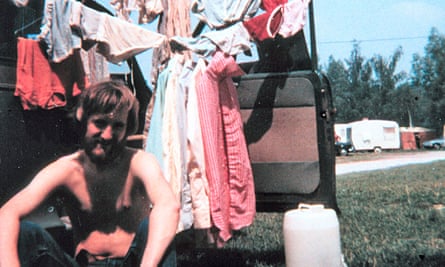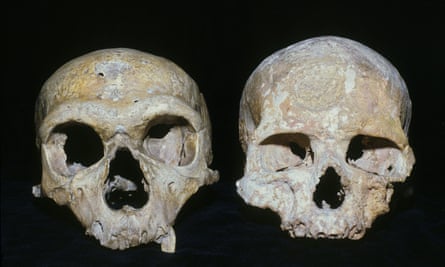As with so many other careers, chance played a major role in my pursuit of science. After a childhood in which I displayed a disquieting interest in skulls and stories about Neanderthals, I was – after a challenging stint as a supply teacher in east London in 1966 – about to train as a doctor at London Hospital medical college when I discovered there was actually a university subject called “anthropology”.
The course included archaeology as well as studies of fossils. My parents were unsure but in the end backed my switch away from medicine. I started a course – at University College London – that included behind-the-scenes visits to London’s Natural History Museum.
There I was shown genuine human fossils, including a Neanderthal skull from Gibraltar. I thought I had died and gone to heaven.
I graduated in 1969 when there was a lack of research opportunities in my field. Indeed, I was lucky again when Don Brothwell secured me a temporary job at the Natural History Museum. I learned a lot but was about to quit academia to become a science teacher when fortune intervened once more. Palaeoanthropologist Jonathan Musgrave, from Bristol University, offered me a PhD grant, and a month later I embarked on a scientific trip that would define my career, change my life – and help reassess our understanding of humanity’s distant past.
My task was straightforward but unusual. I drove my old Morris 1000 from London to Bristol and later across Europe on a 5,000-mile journey around the continent, visiting museums in order to compare fossils of ancient Homo sapiens – such as the Cro-Magnons – with those of Neanderthals.
At the time, the dominant theory of human evolution claimed that Neanderthals were direct ancestors of modern humans. My aim was to test that theory by carefully measuring their skulls and the skulls of Homo sapiens and – by using new statistical methods to compare these two versions of humanity – determine whether or not we were descended from Neanderthals.

It was a great adventure, especially for someone who’d hardly been out of England. I was beset by mishaps, however. I was robbed twice, and then refused entry into communist Czechoslovakia where the museum at Brno held key specimens of both Neanderthals and Cro-Magnons. I was eventually admitted when the border guards decided I looked (then) like “Comrade Che”. My scruffy beard had produced unexpected dividends.
On other occasions, my tent was swept away during a thunderstorm in Prague, my car exhaust collapsed and had to be held on with a coat hanger, and I lost 6kg (13lb) in weight.
On the other hand, l returned intellectually fattened with detailed measurements of more than 100 fossils, a data set that was further enhanced by the American anthropologist William Howells, who donated his hard-won analyses on thousands of recent skulls, which I could use to measure the variation in our species today.
I was then able to access the central computer at Bristol University, which was a major bonus – although it actually had less processing power than a modern wristwatch. From these calculations, I determined that Neanderthals were unlikely ancestors for Homo sapiens, who had appeared in Europe and Asia about 40,000 years ago. However, in 1974 I couldn’t tell who our real ancestors were or where they had lived.
There were many reasons for this uncertainty, including a lack of informative fossils and a lack of genetic information that could be obtained from them. Today we accept that detailed DNA analysis of ancient bones can reveal key data but the idea was viewed as a scientific impossibility in the 1970s. To make matters worse, the ages of many of the fossils and sites looked far too young, especially for some crucial sites in Africa. Radiocarbon dating was still in its infancy and was prone to unrecognised contamination that could make age estimates more recent than they actually were.
A key example was provided by the Jebel Irhoud fossil skull found in Morocco in the 1960s, then kept in the Musée de l’Homme in Paris. I was only able to measure it with the covert help of palaeoanthropologist Yves Coppens after a curator tried to block my access. The skull was thought to belong to a 40,000-year-old African Neanderthal. But as soon as I looked at it, I recognised a sapiens-looking face, albeit a primitive one, and not a Neanderthal.

But could this really be a sapiens ancestor when it was also quite primitive but only 40,000 years old? Like other finds uncovered at this time, the skull was interpreted as showing that Africa lagged far behind Europe and Asia in the development of “modern” humans and their complex behaviour. In fact, thanks to new excavations and studies, it transpires the Jebel Irhoud fossil is actually about 300,000 years old and thus a very plausible ancestral form for Homo sapiens.
It was strong evidence, I later realised, that supported the idea that modern humans have a recent African origin.
By the later 1980s, new discoveries and dating techniques were opening up the debate about the origin of our species. On one side, scientists like me argued for a recent African origin – say 100,000 to 200,000 years ago – while a group known as the multiregionalists, who were led by Milford Wolpoff and Alan Thorne, claimed Homo sapiens had existed for nearly 2m years.
According to their argument, our predecessors included the Neanderthals and the more primitive Homo erectus in places such as China and Indonesia. Neanderthals were direct ancestors of modern Europeans, while distinctive features in million-year-old Homo erectus fossils from China and Java could be seen in their descendants in those regions today.
In other words, the appearance of modern humans was not a special evolutionary event, according to this vision. It was just the end result of more than 1m years of gradual change in populations across the world. First early humans emerged from Africa almost 2m years ago and slowly evolved into the Inuit, native Australians and all other diverse peoples of our planet.
I challenged this view – with my museum colleague Peter Andrews – in a paper in Science. There was no evidence of deep continuity from ancient humans like Homo erectus to modern humans outside Africa, and the features of today’s Chinese and native Australians were probably at most 50,000 years old, rather than more than 1m, we argued.
New dating provided powerful backing for our ideas. In Israel, Neanderthal fossils were being given ages that were younger than some Homo sapiens remains found there – yet the latter was supposed to be descended from the former.
By this time, Rebecca Cann and colleagues at the University of California, Berkeley, had produced a paper that put human origins on front pages round the world. They took samples for mitochondrial DNA (mtDNA) from about 150 placentas representing different human populations and built up their genetic sequences. Because mtDNA is directly passed from mothers to daughters, a sequence of female ancestors could be extrapolated back in time until this reached a single female ancestor who became known as “mitochondrial Eve”.
Their analyses implied that this woman lived in Africa, and mutation rates for mtDNA evolution suggested that was about 200,000 years ago.
This was strong support for an African origin, and it didn’t use a single fossil. Our inclusion of these genetic results in our papers and conference presentations, and our preference for a recent African origin for modern humans from the fossils, caused outrage among the multiregionalists and led to a damaging schism in palaeoanthropology that still rumbles on to this day.
The arguments became personal, and I regret the part I played in that at times. We should try to be objective when our own ideas are criticised, as that is how science progresses, but scientists are only human and can identify too closely with their theories.
Probably the most important contribution to our understanding of the origin of our species began a decade later, using a specimen from the original skeleton that had been found in the Neander Valley near Dusseldorf in 1856: the one that gave rise to the name Neanderthal. Researchers led by Svante Pääbo – who was awarded a Nobel prize for his work last year – showed that the DNA of Neanderthals clearly indicates that they came from a separate lineage from all recent humans. By 2010, Pääbo’s team managed to create a draft whole genome of a Neanderthal – a stunning achievement – which reaffirmed their distinctiveness from us.
However, there was a surprising detail in this work, and that forced me to rethink my ideas about the Neanderthals. I had consistently argued that it was unlikely we had any DNA from Neanderthals. I thought interbreeding with them might have happened occasionally, as it does between baboon species today. But in my view it would have been very rare, and all trace of it would have been lost in the 40,000 years or so since our paths crossed in Europe and Asia. Thus we were essentially 100% recent African origin.
How wrong I was. The 2010 paper and those that followed showed that people outside Africa have inherited about 2% of their DNA from Neanderthals through ancient interbreeding. We know that our species had an evolutionary gestation in Africa stretching back over 300,000 years, but about 60,000 years ago a small group of pioneers left the homeland and entered western Asia. Soon after that they encountered their evolutionary cousins the Neanderthals and interbred with them (the exact details are still the source of much speculation).
In this way, they acquired their DNA which they carried with them as they spread around the rest of the world.
So we are not essentially 100% recent African origin, as I would have said 20 years ago, and bits of the Neanderthal genome live on in us today. This shows how complex things have become – we did not evolve from Neanderthals, but they are partly our ancestors.
And the surprises in 2010 did not stop with Neanderthal interbreeding. Pääbo’s group identified a previously unrecognised kind of human – the Denisovans – from a whole genome recovered from a finger bone fragment found in a Siberian cave. These ancient people also left their mark on us today through interbreeding before they disappeared, and traces of their DNA can be found in east Asians and Native Americans today, with much larger amounts (about 4%) in parts of south-east Asia, Oceania and Australasia.
Chinese fossils such as a strongly built jawbone from Xiahe probably also represent the Denisovans, as might the beautifully preserved fossil cranium from Harbin (“Dragon Man”), which I was recently privileged to study with Chinese colleagues.
Such surprises show us how much we still have to learn about our evolution. Vast areas of Africa have still not produced a single ancient fossil bone or skull, though we know that people were there from the stone tools they left behind.
Even supposedly well-explored regions like South Africa can yield shocks, such as the discovery of the primitive Homo naledi in 2013, a small-brained hominin but dating from only around 300,000 years ago.
The Indian subcontinent still has only one significant ancient human fossil – the enigmatic Narmada cranium found in 1982 – while the islands of south-east Asia have produced two huge bombshells this century: the small-bodied and strange H. floresiensis (aka “the Hobbit”) from Flores in 2003, and the primitive H. luzonensis from the Philippines in 2019.
We have little idea of how to fit them into the big picture of human evolution. Far from becoming a simplified field, human ancestry is becoming far more complex and increasingly exciting – and I cannot wait to see what comes next.


